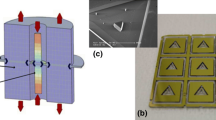Abstract
Quartz crystal resonators find application as precision frequency sources and clocks and are often used in spacecraft, beacons, receivers, and transmitters.1 Quartz is a crystalline material having a high degree of anisotropy. For example, the temperature coefficient of quartz along the optic or z-axis is 8 × 10-6 per degree centigrade, whereas perpendicular to the z-axis it is 15 × 10-6 per degree centigrade. Crystal resonators are now manufactured from synthetically grown quartz, which undergoes several different processing steps to increase the frequency stability of the piezoelectric crystal. Quartz crystal resonators are, for example, electrostatically swept so that impurities located within the quartz material can be removed. Furthermore, the radiation susceptibility of quartz resonators can be reduced by preconditioning them with low doses of ionizing radiation like 1.25-MeV photons from a cobalt 60 source.2,3 Quartz crystal resonators are manufactured from synthetic quartz having very low levels of impurities (<1 ppm) and minimum twinning defects. This process leads to so-called Premium Q quartz for high-precision resonator applications. The unloaded Q or quality factor is typically about 2.5 to 3.0 × 106 for 5-MHz resonators.
Access this chapter
Tax calculation will be finalised at checkout
Purchases are for personal use only
Preview
Unable to display preview. Download preview PDF.
Similar content being viewed by others
References
L.E. Halliburton and J.J. Martin, Properties of piezoelectric materials, in: “Precision Frequency Control, Vol. 1,” E.A. Gerber and A. Ballato, eds., Academic Press, New York (1985).
J.R. Norton, J.M. Cloeren, and J.J. Suter, Results from gamma ray and proton beam radiation testing of quartz resonators, IEEE Trans. Nucl. Sci. NS-31 (5):1230 (1984).
J.J. Suter and R.H. Maurer, Low and medium dose radiation sensitivity of quartz crystal resonators with different aluminum impurity contentIEEE Trans. Ultrason. Ferroelectr. Freq. Contr. UFFC34 (6):667 (1987).
J.R. Norton and J.M. Cloeren, Precision quartz oscillators and their application in small satellites, in: “Proc. 6th Ann. AIAA/USU Conf. on Small Satellites” (1992).
J.R. Norton and R.J. Besson, Tactical BVA quartz resonator performance, in: “Proc. 48th Ann. Symp. on Frequency Control” (in press, 1993).
J.J. Suter, R.H. Maurer, and J.D. Kinneson, “The Susceptibility of Electrodeless Quartz Crystal BVA Resonators to Proton Ionization Effects,” IEEE Trans. Nucl. Sci. NS-35:451 (1988).
J.F. Nye, “Physical Properties of Crystals,” Claridon Press, Oxford, England (1985).
R.J. Besson, “Resonateur a Quartz a Electrodes non Adherentes au Crystal,” Demande de Brevet d’Invention, No: 7601035, Institut National de la Propriete Industrielle Paris (1976).
J.J. Suter, R.H. Maurer, J.D. Kinnison, J. Vig, R. Besson, and A. Koehler, The effects of ionizing and particle radiation on precision frequency standards, in: “Proc. 46th Ann. Symp. on Frequency Control,” 798 (1992).
T.M. Flanagan, R.E. Leadon, and D. L. Shannon, Evaluation of mechanisms for low-dose frequency shifts in crystal oscillators, IEEE Trans. Nucl. Sci. NS-33 (6):1447–1453 (1986).
J.A. Barnes et al., Characterization of frequency stability, IEEE Trans. Instrum. Meas. IM-20 (2):105–120 (1971).
W.C. Lindsay and C.M. Chie, Identification of power-law type oscillator phase noise spectra for measurements, IEEE Trans. Instrum. Meas. IM-27 (1):46–53 (1978).
W.P. Robins, “Phase Noise in Signal Sources,” Peter Peregrinus Ltd., London (1984).
D.W. Allan, Should the classical variance be used as a basic measure in standards metrology?, IEEE Trans. Instrum. Meas. IM-36 (2):646–654 (1987).
Author information
Authors and Affiliations
Editor information
Editors and Affiliations
Rights and permissions
Copyright information
© 1994 Springer Science+Business Media New York
About this chapter
Cite this chapter
Suter, J.J., Norton, J.R., Besson, R. (1994). Electrical Characterization of Precision Piezoelectric Quartz Crystal Resonators. In: Green, R.E., Kozaczek, K.J., Ruud, C.O. (eds) Nondestructive Characterization of Materials VI. Springer, Boston, MA. https://doi.org/10.1007/978-1-4615-2574-5_60
Download citation
DOI: https://doi.org/10.1007/978-1-4615-2574-5_60
Publisher Name: Springer, Boston, MA
Print ISBN: 978-1-4613-6100-8
Online ISBN: 978-1-4615-2574-5
eBook Packages: Springer Book Archive




